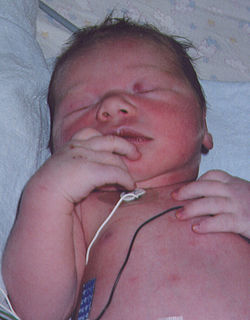Blue baby syndrome

Editor-In-Chief: Prab R Tumpati, MD
Obesity, Sleep & Internal medicine
Founder, WikiMD Wellnesspedia &
W8MD medical weight loss NYC and sleep center NYC
| Blue baby syndrome | |
|---|---|

| |
| Synonyms | N/A |
| Pronounce | N/A |
| Specialty | N/A |
| Symptoms | Cyanosis, dyspnea, tachycardia, fatigue |
| Complications | Hypoxia, heart failure, developmental delay |
| Onset | Neonatal |
| Duration | Varies depending on underlying cause |
| Types | N/A |
| Causes | Congenital heart defects, methemoglobinemia |
| Risks | Genetic factors, environmental factors |
| Diagnosis | Physical examination, pulse oximetry, echocardiogram, blood test |
| Differential diagnosis | Respiratory distress syndrome, pneumonia, sepsis |
| Prevention | N/A |
| Treatment | Oxygen therapy, surgery, medication |
| Medication | N/A |
| Prognosis | Depends on underlying cause and treatment |
| Frequency | Rare |
| Deaths | N/A |
Blue baby syndrome is a condition that affects newborns, causing a blue or purple tint to the skin, lips, and nail beds. This is due to a lack of oxygen in the blood, a condition known as hypoxemia. The medical term for blue baby syndrome is cyanotic heart disease.

Causes[edit]
Blue baby syndrome can be caused by a number of different factors. These include:
- Congenital heart defects: These are problems with the heart's structure that are present at birth. They can affect the heart's ability to pump blood and deliver oxygen to the body.
- Methemoglobinemia: This is a condition in which the blood contains an abnormal form of hemoglobin, the protein in red blood cells that carries oxygen. This can prevent the blood from carrying enough oxygen to the body's tissues.
- Respiratory distress syndrome: This is a breathing disorder that is more common in premature babies. It can cause low levels of oxygen in the blood.
Symptoms[edit]
The main symptom of blue baby syndrome is a blue or purple tint to the skin, lips, and nail beds. Other symptoms can include:
- Shortness of breath
- Rapid breathing
- Fatigue
- Poor weight gain
Diagnosis[edit]
Blue baby syndrome is usually diagnosed through a physical examination and a series of tests. These can include:
- Blood tests: These can measure the amount of oxygen in the blood and detect any abnormal forms of hemoglobin.
- Echocardiogram: This is an ultrasound of the heart. It can show any structural problems with the heart that could be causing the symptoms.
- Chest X-ray: This can show any abnormalities in the lungs that could be causing the symptoms.
Treatment[edit]
Treatment for blue baby syndrome depends on the underlying cause. It can include:
- Medication: This can include drugs to increase the amount of oxygen in the blood or to treat any underlying conditions.
- Surgery: In some cases, surgery may be needed to correct a congenital heart defect.
- Oxygen therapy: This involves breathing in pure oxygen to increase the amount of oxygen in the blood.
Prognosis[edit]
The prognosis for blue baby syndrome depends on the underlying cause and the severity of the symptoms. With early diagnosis and treatment, many babies with this condition can go on to lead healthy lives.
Ad. Transform your life with W8MD's Budget GLP-1 injections from $75


W8MD offers a medical weight loss program to lose weight in Philadelphia. Our physician-supervised medical weight loss provides:
- Weight loss injections in NYC (generic and brand names):
- Zepbound / Mounjaro, Wegovy / Ozempic, Saxenda
- Most insurances accepted or discounted self-pay rates. We will obtain insurance prior authorizations if needed.
- Generic GLP1 weight loss injections from $75 for the starting dose.
- Also offer prescription weight loss medications including Phentermine, Qsymia, Diethylpropion, Contrave etc.
NYC weight loss doctor appointmentsNYC weight loss doctor appointments
Start your NYC weight loss journey today at our NYC medical weight loss and Philadelphia medical weight loss clinics.
- Call 718-946-5500 to lose weight in NYC or for medical weight loss in Philadelphia 215-676-2334.
- Tags:NYC medical weight loss, Philadelphia lose weight Zepbound NYC, Budget GLP1 weight loss injections, Wegovy Philadelphia, Wegovy NYC, Philadelphia medical weight loss, Brookly weight loss and Wegovy NYC
|
WikiMD's Wellness Encyclopedia |
| Let Food Be Thy Medicine Medicine Thy Food - Hippocrates |
Medical Disclaimer: WikiMD is not a substitute for professional medical advice. The information on WikiMD is provided as an information resource only, may be incorrect, outdated or misleading, and is not to be used or relied on for any diagnostic or treatment purposes. Please consult your health care provider before making any healthcare decisions or for guidance about a specific medical condition. WikiMD expressly disclaims responsibility, and shall have no liability, for any damages, loss, injury, or liability whatsoever suffered as a result of your reliance on the information contained in this site. By visiting this site you agree to the foregoing terms and conditions, which may from time to time be changed or supplemented by WikiMD. If you do not agree to the foregoing terms and conditions, you should not enter or use this site. See full disclaimer.
Credits:Most images are courtesy of Wikimedia commons, and templates, categories Wikipedia, licensed under CC BY SA or similar.
Translate this page: - East Asian
中文,
日本,
한국어,
South Asian
हिन्दी,
தமிழ்,
తెలుగు,
Urdu,
ಕನ್ನಡ,
Southeast Asian
Indonesian,
Vietnamese,
Thai,
မြန်မာဘာသာ,
বাংলা
European
español,
Deutsch,
français,
Greek,
português do Brasil,
polski,
română,
русский,
Nederlands,
norsk,
svenska,
suomi,
Italian
Middle Eastern & African
عربى,
Turkish,
Persian,
Hebrew,
Afrikaans,
isiZulu,
Kiswahili,
Other
Bulgarian,
Hungarian,
Czech,
Swedish,
മലയാളം,
मराठी,
ਪੰਜਾਬੀ,
ગુજરાતી,
Portuguese,
Ukrainian


